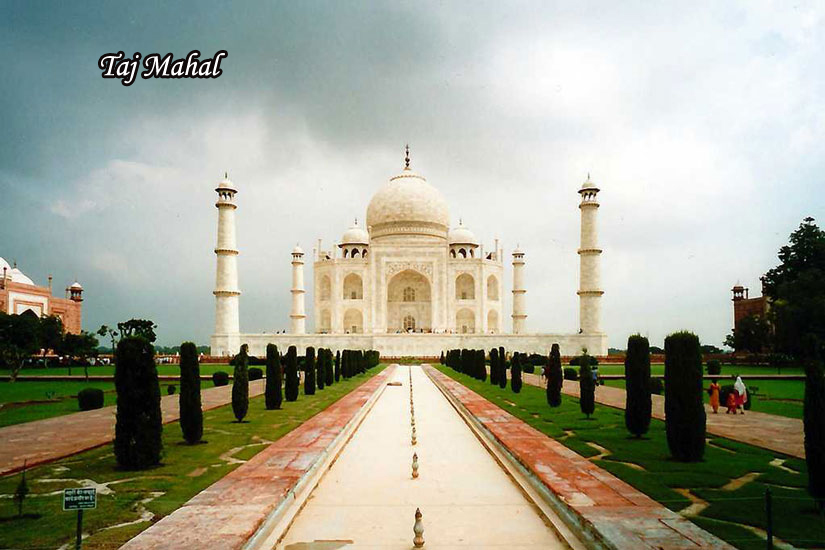
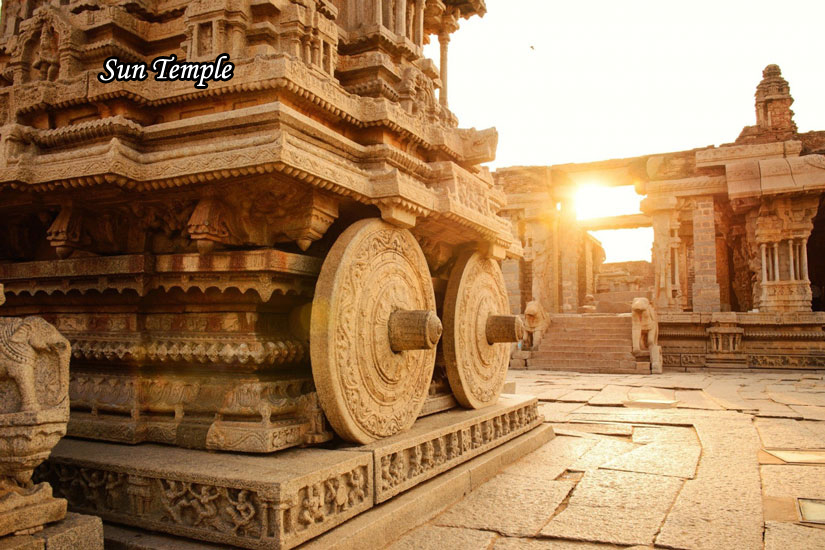
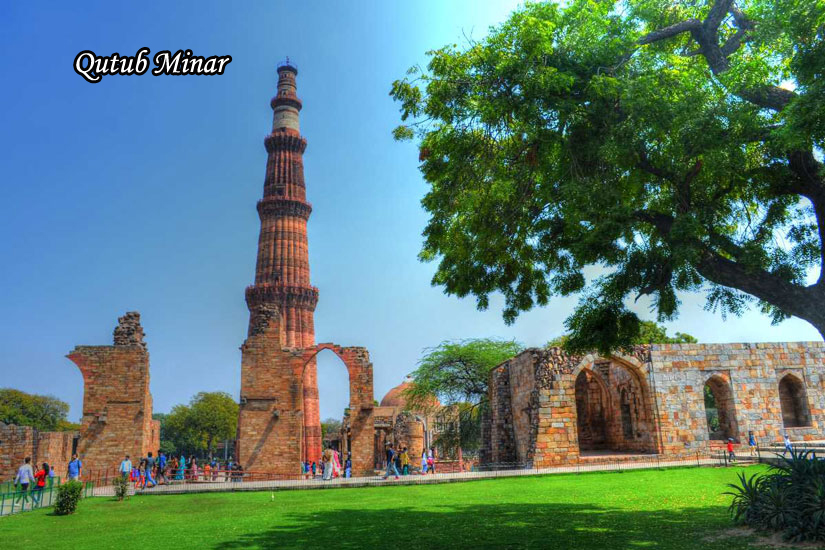

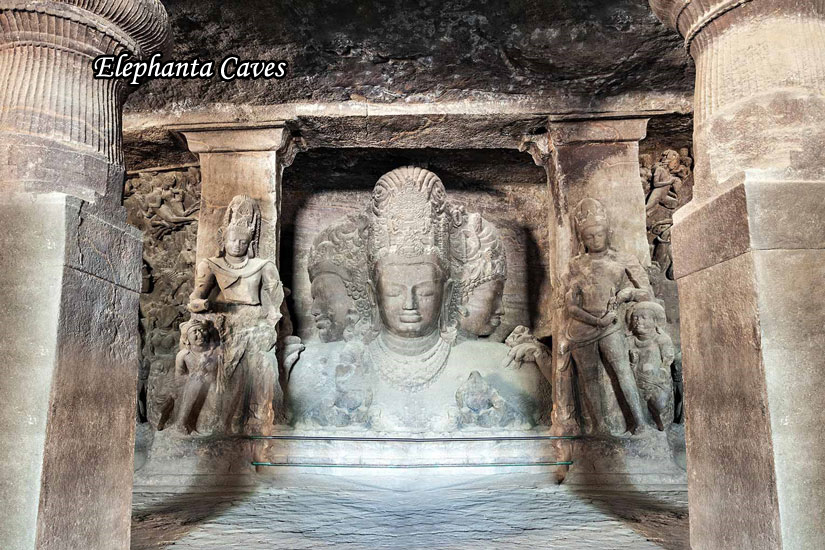


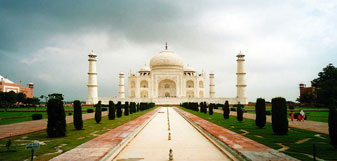
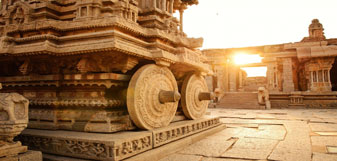
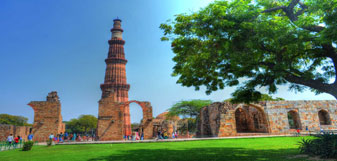



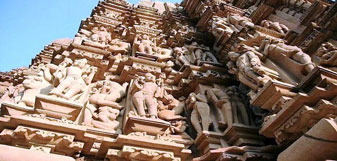
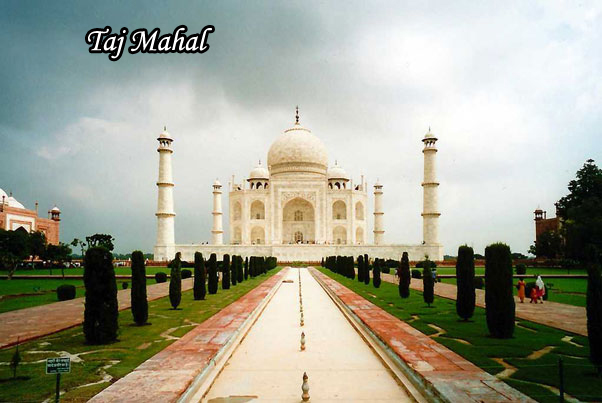
Taj Mahal - The Taj Mahal, an immense mausoleum of white marble, built in Agra between 1631 and 1648 by order of the Mughal Emperor Shah Jahan, is the jewel of Muslim art in India and one of the universally admired masterpieces of the world's heritage. It no doubt partially owes its renown to the moving circumstances of its construction. Shah Jahan, to perpetuate the memory of his favourite wife, Mumtaz Mahal, who died in 1631, had this funerary mosque built. The monument, begun in 1632, was finished in 1648; unverified but nonetheless, tenacious, legends attribute its construction to an international team of several thousands of masons, marble workers, mosaicists and decorators working under the orders of the architect of the emperor, Ustad Ahmad Lahori. Situated on the right bank of the Yamuna in a vast Mogul Garden of some 17 ha, this funerary monument, bounded by four isolated minarets, reigns with its octagonal structure capped by a bulbous dome through the criss-cross of open perspectives offered by alleys or basins of water. The rigour of a perfect elevation of astonishing graphic purity is disguised and almost contradicted by the scintillation of a fairy-like decor where the white marble, the main building material, brings out and scintillates the floral arabesques, the decorative bands, and the calligraphic inscriptions which are incrusted in polychromatic pietra dura. The materials were brought in from all over India and central Asia and white Makrana marble from Jodhpur. Precious stones for the inlay came from Baghdad, Punjab, Egypt, Russia, Golconda, China, Afghanistan, Ceylon, Indian Ocean and Persia. The unique Mughal style combines elements and styles of Persian, Central Asian and Islamic architecture. Other Notable Site in Agra –
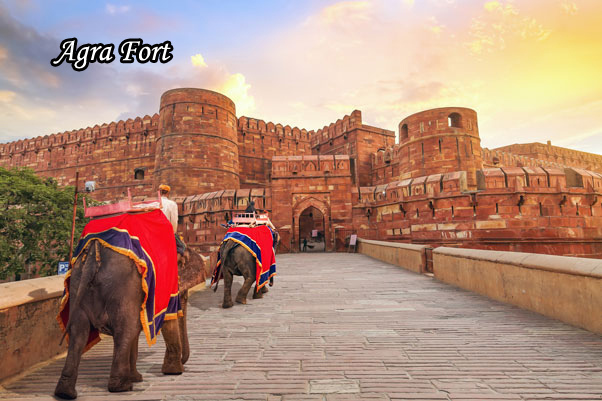
Agra Fort - It was the main residence of the emperors of the Mughal Dynasty till 1638, when the capital was shifted from Agra to Delhi. The Agra fort is a UNESCO World Heritage site. It is about 2.5 km northwest of its more famous sister monument, the Taj Mahal. The fort can be more accurately described as a walled city. Fatepur Sikri - Mughal emperor Akbar built his capital at Fatehpur Sikri between 1572 and 1585 AD. It was constructed using red sandstone. It is said that the emperor, who wished for a son, went to Sikri to get blessed by a Sufi saint, Sheikh Salim Chishti. Jama Masjid - Built by Shah Jahan in 1648 AD, it was dedicated to his daughter, Jahanara Begum. Located just opposite the Agra Fort, the Jama Masjid is one of the largest mosques in India. It is constructed on a large platform which is accessible by a flight of 35 steps. Kalakriti Cultural Convention Centre – There is a show named ‘Mohabbat-e-Taj’ that is held at Kalakriti Cultural and Convention Centre in Agra to depict the saga of Mumtaj Mahal and Shah Jahan and it is a live show. The show presents splendid lifestyle of Mughal dynasty. The most attractive part of the show is the replica of the Taj Mahal which is shown in the end of the show. Shilpgram - A place in Agra which brings in artisans and craftsmen who specialise in unique and ethnic handicraft under a single roof. This tradition of making handicraft is limited to a set of artisans and has been handed over for generations. It is an effort to motivate these artisans and keep the tradition from perishing in this fast-paced era.
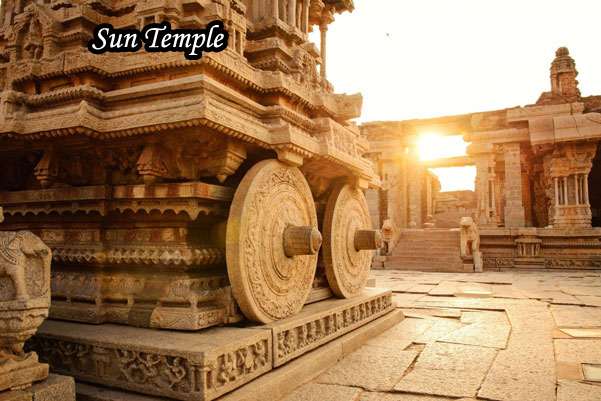
Sun Temple - Konârak is an outstanding testimony to the 13th-century kingdom of Orissa. It is directly and materially linked to Brahmin beliefs and forms the invaluable link in the history of the diffusion of the cult of Surya, which originated in Kashmir during the 8th century and finally reached the shores of eastern India. Konârak derives its name from Konârka, the presiding deity of the Sun Temple. Konârka is a combination of two words, kona (corner) and arka (Sun). It was one of the earliest centres of Sun worship in India. Built around 1250 in the reign of King Narasingha Deva (1238-64), it marks the apogee of the wave of foundations dedicated to the Sun God Surya; the entire temple was conceived as a chariot of the Sun God with a set of spokes and elaborate carvings. The present Sun Temple was probably built by King Narashimhadev I (1238-64) of the Ganga dynasty to celebrate his victory over the Muslims. The temple fell into disuse in the early 17th century after it was desecrated by an envoy of the Mughal Emperor Jahangir. The legend has it that the temple was constructed by Samba, the son of Lord Krishna. Samba was afflicted by leprosy and after twelve years of penance he was cured by Surya, the Sun God, in whose honour he built this temple. –
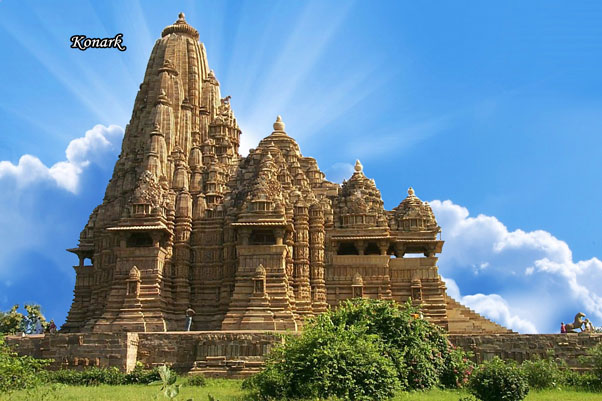
Other Notable Sites in Konark: Chandrabhaga Beach - Located at the Konark, the abode of the magnificent Sun Temple, the beach is known for its stunning sunrise and sunset.As per legend Sambha son of Lord Krishna prayed here to the Sun God and through the latter’s blessings he got rid of leprosy. Thus the beach has an important spiritual significance in Odisha. Astaranga Beach - which literally means “colourful sunset” is an extremely picturesque beach located in the state of Odisha. This beautiful beach is situated in a fishing village called Astarangain the Puri district. In addition, to its scenic beauty this beach is also renowned for providing magnificent views of the setting sun. Furthermore, this beach also comprises of a small fish market that operates every morning. It also serves as a nesting place for the Olive Ridley Turtle species and these turtles can be seen especially during the winter season. Kuruma - Kurumais famous for the excavated site of Buddha Vihar. It is a small village known as Jama –Dharma situated at a distance of 8 kms fromKonark. The village has come to prominence due to discovery of Archaeological remains like the image of Lord Buddha seated in BhumiSparsa Mudra along the image of Heruka (a Buddhist deitya). There is a brick wall measuring 17 mtrs. In length which consists of layers of ancient bricks. The place is also important feeding ground for historical research purpose. Chaurasi Varahi Devi Temple - or Varahi Deula is an ancient temple dedicated to Maa Varahi. The temple is located in the village of Chaurashi and on the right bank of the Prachi river, Odisha. It is about 2 km from Amaresvara temple on the Nimapada-Kakatpur road in the Puri district. The Chaurasi Varahi temple is unique among all Maa Vahari temples in India. The image consecrated in this temple is considered one of the masterpieces among the images of the deity found throughout India.
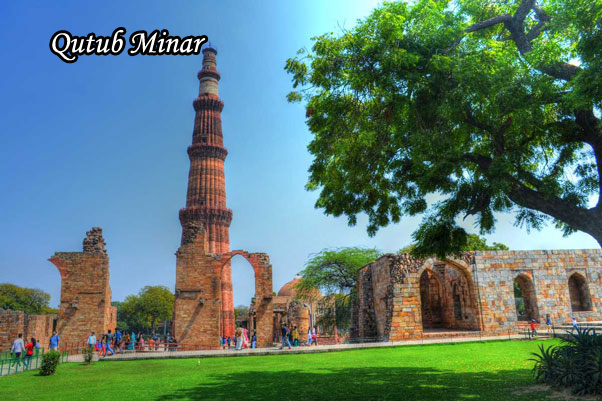
Qutub Minar - Qutub Minar in Delhi is world heritage site. The tall minaret was constructed in 1192 by Qutab-ud-din Aibak, and later completed by his successor Iltutmish. The soaring conical tower is an exquisite example of Indo-Islamic Afghan architecture. The Minar of Delhi is surrounded by a lush green garden, which is an ideal leisurely place for visitors. It is India's most visited monument attracting around 3.9 million visitors every year. Each of the 5 storeys and tower of Qutub Minar has unique designs. It was hit by lightening couple of times and was damaged. The base of the Qutub Minar measures 14.32 meters and the top of the structure measures 2.75 meters. The bird eye's view of Delhi city from the top is amazing. The base of first storey has alternate angular and circular flutings, the second one is round. The third storey of the Qutub Minar has angular flutings. The balconies projecting out heighten the beauty of the Minar. The tower is so high that around 379 steps are needed to be climbed to reach the top. Another taller tower adjacent to Qutub Minar is named Alai Minar which is somewhat tilted in one direction. The verses from the holy Qur'an are carved on sandstone walls of Qutub Minar. This monument serves the purpose of calling people for prayer in the Quwwat-ul-Islam mosque. This is a tower of victory, a monument that signify the might of Islam, or a tower for keeping a check for defence. Other Notable Sites in Delhi: –
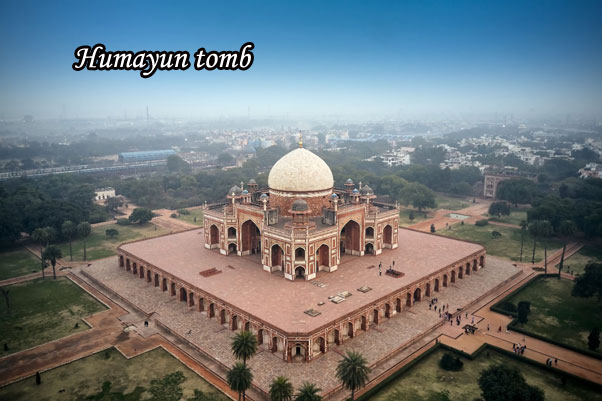
Humayun Tomb - Exemplifying the formative stage of the Mughal structural style, Humayun's Tomb stands as a landmark in the development of Mughal architecture, and also represents the earliest extant specimen of the Mughal scheme of the garden tomb, with causeways and channels.
Red Fort - The Red Fort Complex was built as the palace fort of Shahjahanabad – the new capital of the fifth Mughal Emperor of India, Shah Jahan. Named for its massive enclosing walls of red sandstone, it is adjacent to an older fort, the Salimgarh, built by Islam Shah Suri in 1546, with which it forms the Red Fort Complex.
Chandni Chowk – or the Moonlight Square, in Old Delhi was designed and established by Princess Jahanara, Mughal Emperor Shah Jahan’s Favourite Daughter in 1650 C.E. It is one of the oldest and busiest markets in Old Delhi. Chandni Chowk’s speciality is the variety of its markets and their Indianness, from authentic Indian Food, Sweets, Clothing to Jewellery. There are many narrow lanes each with unique name, with shops selling clothing, shoes, leather goods etc.
Bangla Sahib Gurudwara - Built in the sacred visit of SRI GURU HARKRISHAN JI to Delhi. At the request of Mughal King Aurangzeb and through the persuasion of Mirza Raja Jai Singh of Amber, GURU SAHIB agreed to come to Delhi.
India Gate - Synonymous with New Delhi and situated in the heart of the city, India Gate is one of the most popular monuments in the city. The foundation stone of India Gate was laid in 1920 and the structure was unveiled in 1933. Designed by Edwin Lutyens, India Gate was dedicated to all the Indian soldiers of the British Army who died in World War I.
Lotus Temple - this temple is built in the shape of a lotus flower and is the last of seven Major Bahai's temples built around the world. Completed in1986 it is set among the lush green landscaped gardens. The structure is made up of pure white marble The architect Furiburz Sabha chose the lotus as the symbol common Hinduism, Buddhism, Jainism and Islam. Adherents of any faith are free to visit the temple and pray or meditate.
Agersen Ki Baoli - Legends say that this stepwell was built by the King Agrasen, which is derived from Ugrasen. Even today the name plate at the entrance says 'Ugrasen Ki Baoli'. Historical records say that Agrasen Ki Baoli was rebuilt over the old stepwell by the rich Agarwal Community, who are said to be the descendants of Maharaja Agrasen. So, today's structure belongs to the 14th century during the rule of Tuglaqs in Delhi.
Lodhi Art District - India's first-ever open-air art district where 25 street artists from India and around the world came together to paint the walls and create a masterpiece. This project was started by St+art India, a non-profit organisation that is on a mission to make art accessible to everyone. These painted walls have been grabbing the eyeballs for all the right reasons and even The First Lady of France, Brigitte Macron has visited the art district.
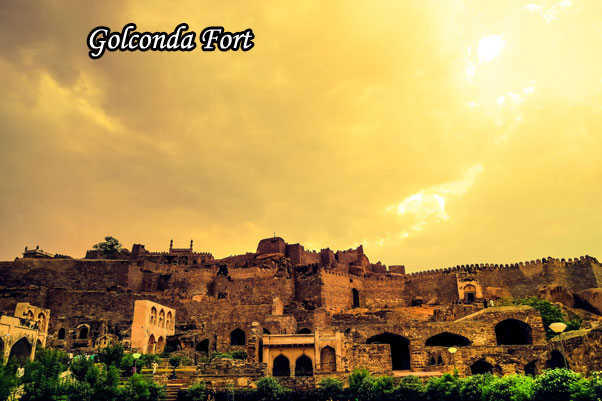
Golconda Fort - Golconda fort is undoubtedly one of most magnificent fortress complexes in India. The history of Golconda Fort goes back to early 13th century, when it was ruled by the Kakatiya’s followed by Qutub Shahi kings, who ruled the region in 16th and 17th century. The fortress rests on a granite hill 120 meters high while huge crenelated ramparts surround this structure. It was initially called Shepherd’s Hill, meaning Golla Konda in Telugu while according to legend, on this rocky hill a shepherd boy had come across an idol and the information was conveyed to the ruling Kakatiya king at that time. The king constructed a mud fort around this holy spot and after 200 years, Bahamani rulers took possession of the place. Later the Qutub Shahi kings converted this into massive granite fort extending 5km in circumference. The fort is considered a mute witness to historic events. The Qutub Shahis reign at Golconda ended in 1687 when it was run over by Mughal emperor Aurangzeb, who intentionally left it in ruins Golconda still boasts of mounted cannons, four drawbridges, eight gateways, and majestic halls, magazines, stables etc. The outermost enclosure is called Fateh Darwaza meaning Victory gate, after Aurangzeb’s army marched successfully through this gate. At Fateh Darwaza one can witness fantastic acoustical effects, which is one among the many famous engineering marvels at Golconda. Other Notable Sites in Hyderabad:
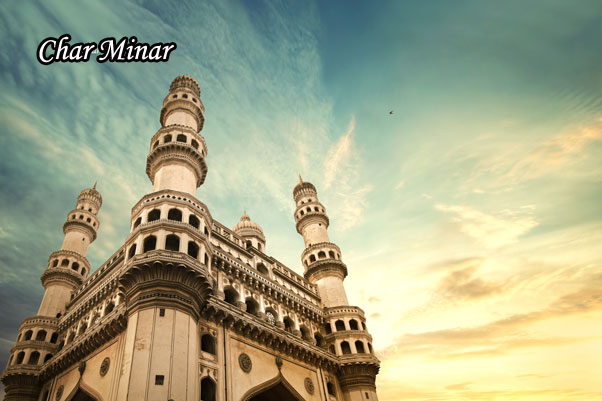
Char Minar - The Charminar was built in 1591 by Mohammed Quli Qutub Shah, the fifth sultan of the Qutub Shahi dynasty of India. There are varying legends as to why he built the magnificent structure. One account says that the sultan built it in honor of his wife, Bhagyamathi Chowmahalla Palace - The name Chowmahalla refers to four palaces. The construction of the palace was initiated in the year 1750 by Nizam Salabhat Jung but it was Nizam Afzar-ud-Dawla Bahadur who saw that the palace was completed between the years 1857 and 1869. Hussain Sagar Lake - Large manmade lakes are a testimony to the efforts of our rulers in historical times. Take a stroll across the lake’s boulevards on a pleasant evening and it is when you notice the cool breeze smoothly caressing your senses welcoming you to this place. Faluknama Palace - Perched 2,000 feet above the city of Hyderabad is Taj Falaknuma Palace, a jewel amongst the clouds. Built in 1894, it is the former palace of the Nizam, rumoured to be the richest man in the world at one time. Overlooking the twinkling City of Pearls, this enchanting palace hotel in Hyderabad exudes romance and grandeur that take one back to when the Nizam ruled Hyderabad. Walk the walk of kings through the Grand Staircase to retrace the steps of Nizams, European royalty, enchanting Begums and distinguished Heads of State.

Elephanta Caves - The island of Elephanta, the glorious abode of Lord Shiva and an epitome of Hindu cave culture, consists of seven caves on an island in the Sea of Oman close to Mumbai which, with their decorated temples and the images from Hindu mythology, bear a unique testimony to a civilization that has disappeared. Here, Indian art has found one of its most perfect expressions, particularly in the huge high reliefs in the main cave. The island of Gharapuri, the 'City of Caves', situated about 10 km from Mumbai on the east side of the harbour, owes its name to the enormous stone elephant found there by Portuguese navigators. This elephant was cut into pieces, removed to Mumbai and somehow put together again. It is today the melancholy guardian of Victoria Gardens Zoo in Mumbai, the great metropolis of Maharashtra State and India's second city population-wise. The date of the famous Elephanta Caves is still very much debated and varies from the 6th century to the 8th century according to different specialists. They constitute one of the most striking collections of rock-art in India. There are two groups of caves. To the east, Stupa Hill (thus named because of a small brick Buddhist monument at the top) contains two caves, one of which is unfinished, and several cisterns. To the west, the larger group consists of five rock-cut Hindu shrines. The main cave is universally famous for its carvings to the glory of Shiva, who is exalted in various forms and act ions. The cave consists of a square plan mandapa whose sides measure about 27 m. Other Notable Sites in Mumbai –
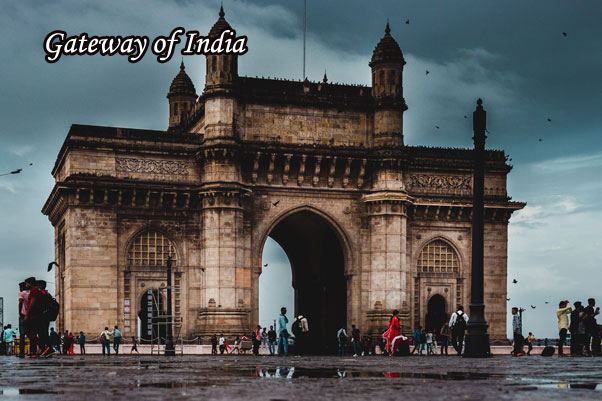
Gateway of India - The Gateway of India is an arch monument built during the 20th century in Bombay, India. The monument was erected to commemorate the landing of King George V and Queen Mary at Apollo Bunder on their visit to India in 1911. The Chhatrapati Shivaji Terminus - formerly known as Victoria Terminus Station, in Mumbai, is an outstanding example of Victorian Gothic Revival architecture in India, blended with themes deriving from Indian traditional architecture. The building, designed by the British architect F. W. Stevens, became the symbol of Bombay as the ‘Gothic City’ and the major international mercantile port of India. The terminal was built over 10 years, starting in 1878. Dabbawala - Since 1890, Dressed in white outfit and traditional Gandhi Cap, Mumbai Army of 5,000 Dabbawalas fulfilling the hunger of almost 200,000 Mumbaikar with home-cooked food that is lug between home and office daily. For more than a century our team have been part of this grime-ridden metropolis-of-dreams. Haji Ali Dargah - one of India’s most famous and prestigious landmarks situated about 500 yards from the Mumbai shoreline in the middle of the Arabian Sea off Lala Lajpatrai Marg. The structure was erected on a set of high rising rocks and was given its present day shape in the early 19th century after the Trust was legally formed as an entity in 1916. Siddhivinayak Temple - Shree Ganesh is the first to be worshipped before beginning any new project or venture as he is the destroyer of obstacles (Vighnaharta). This is Shree Siddhivinayak Ganapati Temple at Prabhadevi in Mumbai, a two-century-old Temple that fulfills the desires of the worshipers. Kanehri Caves - Deeply nestled among the tranquil surroundings of the Sanjay Gandhi National Park, Borivali in Mumbai, are more than 100 Buddhist caves popularly known as the Kanheri Caves. Kanheri, known as Krishnagiri or Kanhagiri in ancient inscription, literally means black mountain (Krishna means black and giri is mountain) and is mostly named after its black basaltic stone. Spanning from the 1st century BC to 11th century AD, an era that saw the rise and decline of Buddhism Mumbai Film City - Your visit to Mumbai is incomplete till you have had a taste of Bollywood. If you have been yearning to see the workings of the film industry up-close, we have it all sorted out for you. Take a Bollywood Tour, check out the behind-the-scenes action and simply live the magic of movies. Bollywood is the world's second largest movie and music industry and India's largest.
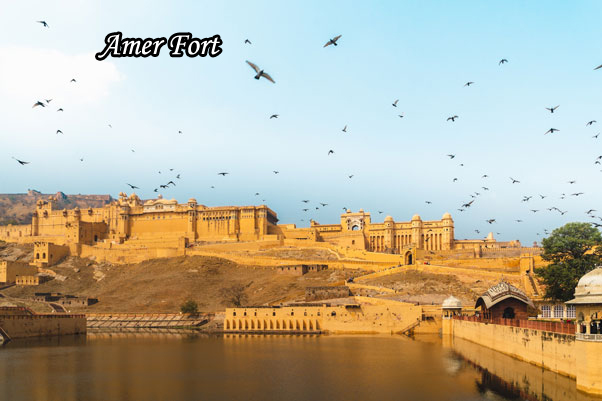
Amer Fort - Amer, originally, was the capital of the state before Jaipur. It is an old fort, built in 1592 by Raja Man Singh. This fort is also very popularly known as the Amer Palace. The Amer Fort was built in red sandstone and marble and the Maotha Lake adds a certain charm to the entire Fort. Though the fort is quite old and may even look so from the outside, it is beautiful on the inside and boasts of various buildings of prominence like the 'Diwan-i-Aam', the 'Sheesh Mahal' and even the 'Sukh Mahal'. The Amer Fort has influences of both Hindu and Muslim architecture. The structure has four different parts, each with a separate entrance. The main entry to the fort is through the 'Suraj Pol' or Sun Gate which opens up into the main courtyard. This east-facing gate is also the main entrance to the palace and its position with respect to the rising sun is the source of its name. The 'Jaleb Chowk' is one of the four courtyards of the Amer Palace. The Amer Fort/Palace is a beautiful structure that was built by Raja Man Sing in the 16th century. Don't forget to check out the 'Sheesh Mahal', 'Diwan-i-Aam' and 'Sukh Mahal' also. The fort is a ten minute walk uphill and your little trek will be worth the wonders that it offers. Don't miss the royal elephant ride while you are at it! Other notable Sites in Jaipur –
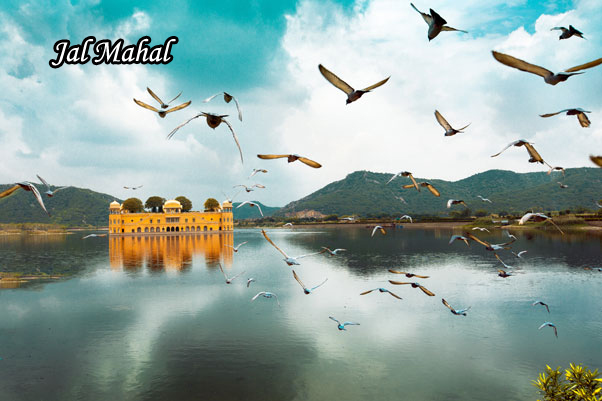
Jal Mahal - The city is dotted with marvelous architectural beauties and Jal Mahal stands at the forefront of these works of art. Standing amidst the center of Man Sagar Lake, the palace, when you first look at it, will give you the illusion of almost floating atop the lake and that is the moment when this sight takes your breath away. Nahargarh Fort - Overlooking the gorgeous Pink City of Jaipur lies a magnificent structure – Nahargarh Fort. Built in 1734 by Maharaja Sawai Jai Singh II, the founder of Jaipur, encompassed a larger than life structure that would not only protect the city but also add to its charm and richness. It was originally named ‘Sudarshangarh Fort’ and was later changed to Nahargarh, which means ‘Abode of Tigers’. City Palace - Located deep within the walled city, the City Palace Complex was conceived and built by Maharaja Sawai Jai Singh II, the founder of Jaipur. A beautiful fusion of Mughal and Rajput architecture, the palace is still home to the last ruling royal family which lives in a private section of the palace. Maharaja Sawai Jai Singh II is credited with building most of the structures, but it was expanded upon by later rulers as well. Hawa Mahal - Hawa Mahal is also known as the Palace of Winds. The word ‘Hawa’ means Wind. An artistic facade, made in the shape of a crown, faces the road on the market area. This facade is what we usually see in most of the pictures of Hawa Mahal. Hawa Mahal was built by Maharaja Sawai Pratap Singh in the year 1799. Jantar Mantar - The Jantar Mantar, in Jaipur, is an astronomical observation site built in the early 18th century. It includes a set of some 20 main fixed instruments. They are monumental examples in masonry of known instruments but which in many cases have specific characteristics of their own. Designed for the observation of astronomical positions with the naked eye, they embody several architectural and instrumental innovations. The Jhalana Leopard Reserve - or Jhalana Safari Park is the Indias 1st Leopard Reserve located in Jaipur city of Rajasthan state, India. It is surrounded by Aravali hills, the oldest mountain series of India. Jhalana became a leopard reserve in 2017. The reserve is spread over an area of 20 square kilometers, with immense flora and fauna present in the park. Hathni Kund Trek - trek spot that goes along the rich green valleys. On the path, trekkers can appreciate the perspective on beautiful scenes with hypnotizing sand ridges all over. The trek to the Hathni Kund has various spots in the middle of like sand rises, thick backwoods, sanctuaries, cascades.
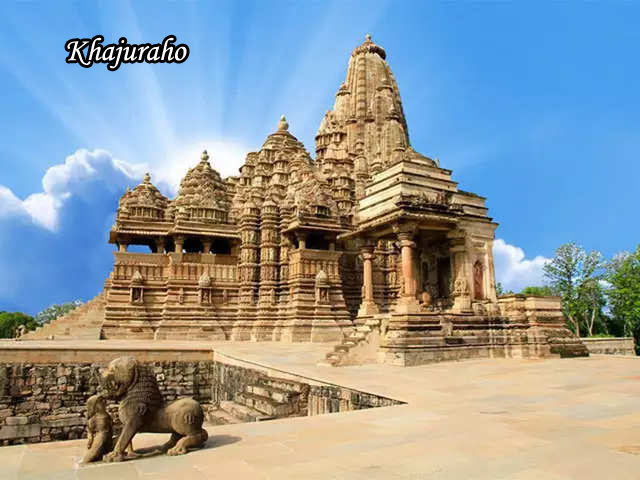
Western & Eastern Temples - Known for the immaculate and erotic sculptures of its temples, Khajuraho has successfully taught the lessons of spirituality over greed. This wondrous heritage town is encircled with the Vindhya Mountain Ranges to make it even more delightful. Listed as a UNESCO World Heritage Site, Khajuraho showcases beautiful inscriptions also. The Khajuraho temples were built in the short span of a hundred years, from 950-1050 AD in a truly inspired burst of creativity. Of the 85 original temples, 22 have survived till today to constitute one of the world's great artistic wonders. The temples of Khajuraho are India's unique gift to the world, representing, as they do, a paean to life, to love, to joy, perfect in execution and sublime in expression. Life, in every form and mood, has been captured in stone, testifying not only to the craftsman's artistry but also to the extraordinary breadth of vision of the Chandela Rajputs under whose rule the temples were conceived and constructed. Other notable Sites in Khajuraho – Raneh Falls - Also known as the ‘Mini Grand Canyon’ of India, the scenic Raneh Falls is situated about 20 kms from Khajuraho. The waterfall is situated on the crater of a dead volcano. You will notice that the crater consists of 5 different types of rocks. Waking up early to experience the picturesque Raneh Falls is definitely worth it. For photo fanatics this place is a paradise. There is also a small museum here which displays information of all the animals found in the area. Archaeological Museum- Archaeological Museum is located near the Western Group of Temples in Khajuraho and was originally known as the Jardine Museum. Housing over 2000 items, the museum has relics from the 10th and 12th century temples of Hinduism and Jainism. Khajuraho Dance Festival- Every year, Khajuraho dance festival is organized in February or March. This festival attracts loads of travellers including the international ones. They attend the festival enthusiastically and they get the opportunity to explore the rich Indian culture and its marvelous history.(br) This festival is organized by the Madhya Pradesh Kala Parishad. Many world famous artists come and perform here. The ambience around is full of art and passion and the background of the magnificent Khajuraho temples enhances the beauty of the festival. Light and Sound Show - Undoubtedly among the most popular Khajuraho things to do in the evenings, the sound and light show held by the Western Group of Temples is a sight to behold. Illustrating various historical and religious facts and cultures of the ancient times, this paid event promises to satiate the burning curiosity of visitors like nothing else. While the temples are beautiful by themselves, the sound and light show bathes them in a whole new light, quite literally.
From caves, temples and mosques to palaces and stupas, India boasts an architectural ...
A nations cultural and natural heritage embodied in buildings, monuments and natural